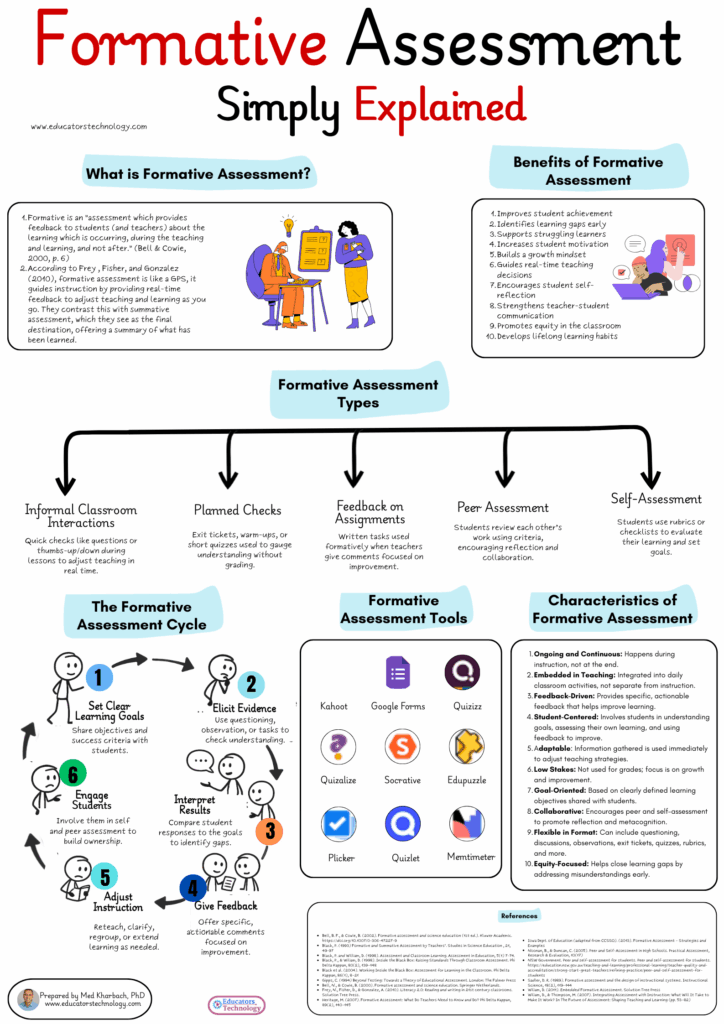Formative assessment is one of the most powerful tools teachers can use to guide learning. Unlike summative assessment, which summarizes achievement at the end of a unit, formative assessment happens throughout the learning process. It’s about checking in, making adjustments, and ensuring that both teachers and students know where they are headed. Let’s break down what it means, why it matters, and how you can use it effectively in your classroom.
What is Formative Assessment?
Formative assessment provides feedback during learning, not after it. As Bell and Cowie (2000) explain, it’s an “assessment which provides feedback to students (and teachers) about the learning which is occurring, during the teaching and learning, and not after.”
Frey, Fisher, and Gonzalez (2010) compare it to a GPS system: it guides instruction in real time, offering the directions you need to adjust teaching as you go.
Benefits of Formative Assessment
Why invest time in formative assessment? The benefits are wide-ranging:
- Improves student achievement
- Identifies learning gaps early
- Supports struggling learners
- Increases student motivation
- Builds a growth mindset
- Guides real-time teaching decisions
- Encourages self-reflection
- Strengthens teacher-student communication
- Promotes equity in the classroom
- Develops lifelong learning habits
Simply put, it turns teaching into a responsive process where feedback drives improvement.
Types of Formative Assessment
Formative assessment isn’t a single technique, it comes in many forms:
- Informal Classroom Interactions: Quick checks like asking questions or using thumbs-up/down signals.
- Planned Checks: Exit tickets, warm-ups, or short quizzes to gauge understanding.
- Feedback on Assignments: Written tasks used formatively with comments for improvement.
- Peer Assessment: Students review each other’s work, encouraging reflection and collaboration.
- Self-Assessment: Learners use rubrics or checklists to evaluate themselves and set goals.
The Formative Assessment Cycle
Effective formative assessment follows a cycle that keeps learning focused and adaptive:
- Set Clear Learning Goals: Share objectives with students.
- Elicit Evidence: Use questioning, tasks, or observations.
- Interpret Results: Look at responses to spot progress and gaps.
- Give Feedback: Provide specific, actionable steps.
- Adjust Instruction: Reteach, clarify, or extend learning.
- Engage Students: Involve them in reflection and ownership.
This cycle ensures assessment is continuous and meaningful.
Formative Assessment Tools
Today’s teachers have a wide range of digital tools to support formative assessment. Some popular ones include:
- Kahoot
- Google Forms
- Quizziz
- Quizalize
- Socrative
- Edpuzzle
- Plicker
- Quizlet
- Mentimeter
These tools make it easier to collect evidence of learning in real time and act on it.
Characteristics of Formative Assessment
Good formative assessment has certain characteristics that make it effective:
- Ongoing and Continuous: Happens during instruction.
- Embedded in Teaching: Integrated into classroom routines.
- Feedback-Driven: Provides actionable feedback.
- Student-Centered: Involves learners in setting and achieving goals.
- Adaptive: Adjusts instruction as needed.
- Low-Stakes: Focused on growth, not grades.
- Goal-Oriented: Aligned with clear learning goals.
- Collaborative: Involves peer and self-assessment.
- Equity-Focused: Addresses learning gaps and misunderstandings.
These characteristics keep the focus on growth and continuous improvement.
Here is the PDF version of the poster below:

The post Formative Assessment Simply Explained appeared first on Educators Technology.







